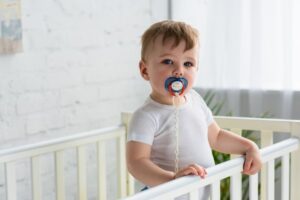
Pacifiers can be a lifesaver for new parents, soothing fussy babies and helping them fall asleep. While they offer comfort and have benefits—such as reducing the risk of sudden infant death syndrome (SIDS)—many parents worry about whether pacifier use could affect their baby’s dental development. The answer isn’t completely straightforward. Pacifiers are generally safe during infancy, but prolonged or improper use can lead to dental issues as a child grows. Here’s what you need to know.
Pacifiers and Infant Development
In the early months of life, pacifiers are considered safe and even helpful. Babies have a natural sucking reflex, and pacifiers can satisfy this need while providing a sense of calm. Most dental professionals agree that pacifiers won’t harm teeth development during the first year of life. Problems tend to arise only if pacifier use continues beyond the recommended age.
Potential Dental Concerns
Long-term pacifier use—especially past the age of 2 to 3—can begin to affect the alignment of a child’s teeth and the growth of their jaw. Common issues include:
- Open Bite: When the front teeth don’t meet properly because of constant sucking pressure.
- Overbite: The upper front teeth may tilt forward, creating spacing and bite issues.
- Crossbite: The upper and lower jaws may not align correctly, leading to chewing difficulties later.
- Changes in Palate Shape: A prolonged sucking habit can subtly alter the shape of the roof of the mouth.
These issues don’t develop overnight, but the longer a child continues using a pacifier, the greater the risk becomes.
Age Recommendations for Pacifier Use
The American Academy of Pediatric Dentistry (AAPD) recommends weaning children off pacifiers by age 2, and definitely by age 3, to minimize the risk of dental problems. At this stage, most children no longer need the comfort they provided as infants, and removing the pacifier helps encourage healthy oral and speech development.
Tips for Healthy Pacifier Use
If you choose to use a pacifier for your baby, these guidelines can help protect their teeth:
- Choose orthodontic pacifiers: These are designed to support natural oral development.
- Never dip pacifiers in sweet substances: Coating a pacifier in honey or juice increases the risk of cavities.
- Keep it clean: Regularly wash pacifiers to prevent bacteria buildup.
- Encourage gradual weaning: Start limiting pacifier use around age 1, using it only for sleep or comfort, then phase it out completely by age 2–3.
What If Dental Issues Occur?
If pacifier use has already affected your child’s teeth, don’t panic. Many alignment problems will correct themselves once the habit stops, especially if it’s discontinued early. If issues persist, your pediatric dentist can recommend monitoring or early orthodontic evaluation.
Pacifiers can be a helpful tool for babies and parents alike, but moderation is key. Using them in the first year is generally safe, but prolonged use beyond toddlerhood can interfere with proper dental and jaw development. By following age recommendations and weaning your child off the pacifier at the right time, you can balance the comfort it provides with the long-term health of your child’s smile.
About the Practice
Here at G&G Pediatric Dentistry & Orthodontics, we believe in protecting smiles from the start. That’s why we invite you to bring your little one in for preventive care! We’re a husband-and-wife-led practice here in the Naperville area, the first of its kind. We welcome patients with special needs and are even fluent in American Sign Language to meet our patients where they are. Come see why we’re a trusted provider of dental care for children. Schedule your appointment online or call us at (630) 778-9500.



